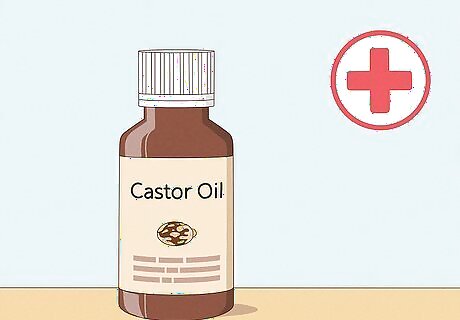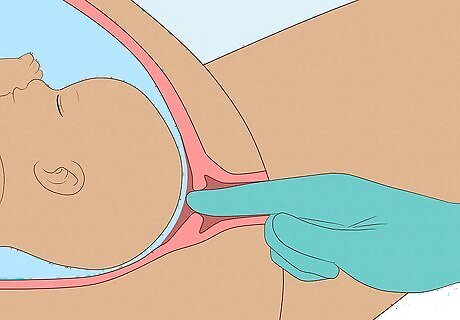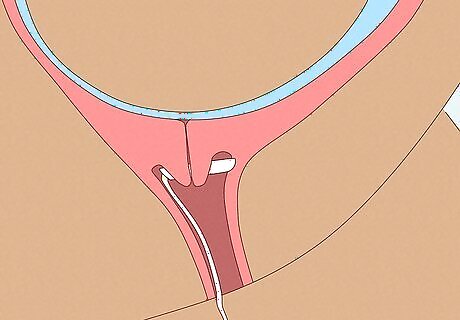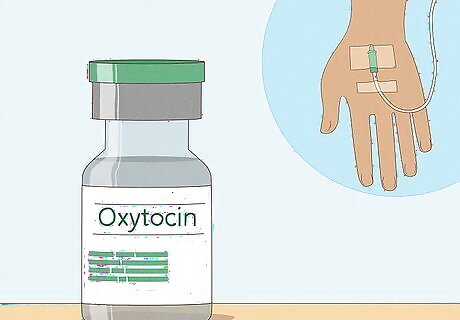
views
- Dilate faster at home by walking around to release oxytocin.
- Try sexual intercourse or nipple stimulation to soften your cervix.
- Eat pineapple or spicy foods to dilate faster.
- Ask your doctor about medical treatments if you’re past your due date or your water has already broken.
At-Home Methods

Walk to release oxytocin and stimulate labor. Being active may release oxytocin, which may help you dilate faster by starting contractions. Go for a slow walk around your neighborhood, or climb the stairs in your home. If you’re in labor or are close to labor, ask a friend or family member to go with you in case you need help. Light exercises, like walking up and down stairs or sitting on an exercise ball, may also help.

Have sex to stimulate your uterus and induce labor. Your brain releases the hormone oxytocin during sex, which also helps start contractions. Try having sex to help you dilate faster if it’s something you’ll enjoy. Rest assured that having sex this late in your pregnancy isn’t harmful to you or your baby. If your water is already broken, don’t have sex. The baby is no longer protected by amniotic fluid, and sex could hurt them. Both an orgasm and the prostaglandins in semen naturally stimulate your uterus and thin your cervix, which helps it dilate.

Try stimulating your nipples to release oxytocin. Gently rub the pad of your finger over your nipple or roll the nipple under your finger. You should feel a tingling sensation, which means your nipples are stimulated. When this happens, your brain will release oxytocin to help start your contractions. Stimulating your nipples releases a low amount of oxytocin that is safe for your baby. If your pregnancy is considered high-risk, do not try nipple stimulation without consulting your doctor or midwife first.

Use visualization and deep breathing to relax. Feeling tense makes it difficult for your body to start contractions, which slows dilation of your cervix. Fortunately, relaxing may enable your body to begin contractions. Visualize by imagining yourself in a relaxing location or picturing yourself having a healthy baby. Take deep breaths while counting to 5 and exhale to a 5 count, then repeat that 5 times. You might also try listening to calming music, taking a warm shower, or reading a book. Anything that helps you feel calm, cool, and collected will help. Looking for more relaxation? Preliminary studies show that acupressure may help induce labor, although more research is needed.

Eat pineapple to ripen your cervix and help it dilate faster. Studies are limited, but preliminary research shows that the bromelain in pineapple may help dilate your cervix faster. Try eating 1/2 cup (113 g) of pineapple every day until you go into labor to speed up the process. Other tropical fruits, like kiwi, mango, and papaya may have the same effect. If you like fruits, there’s no harm in trying this method, even if it doesn’t work.

Drink raspberry leaf tea to speed up contractions. Studies on raspberry leaf tea aren’t extensive, but many people claim that drinking it made their labor shorter and their contractions more effective. Try drinking a cup of raspberry leaf tea to tone the uterus and dilate faster. If the tea upsets your stomach, stop drinking it and talk to your doctor or midwife.

Eat spicy foods to stimulate your bowels. While there are no studies showing that spicy foods will dilate the cervix faster, many people swear that spicy foods help induce labor. The mild laxative effect of spicy foods will stimulate the bowels, which could lead to stimulating the uterus. Try eating something spicy to see if it helps you and your body. Try food like jalapeno peppers, curry, salsa, or anything with fresh garlic.

Ask your doctor or midwife about taking castor oil. Castor oil is a laxative, meaning it will stimulate the intestines (and, in turn, can stimulate the uterus). However, castor oil isn’t for everyone, and it can cause some side effects, like diarrhea or an upset stomach. Check in with your doctor or midwife, then take as much castor oil as they recommend. Castor oil can also cause dehydration, so be sure you’re getting enough liquids.
Medical Treatments

Talk to your doctor about membrane stripping. Membrane stripping is when a medical professional inserts their fingers into the vagina and separates the amniotic sac from the cervix. This may help release prostaglandins, a hormone that softens the cervix faster. However, this treatment is not recommended for everyone, and it can be risky. Risks include breaking the water early, starting contractions that don’t lead to labor, and infection. Talk to your doctor or midwife to see if membrane stripping is right for you and your baby.

Ask your doctor about taking prostaglandins to ripen your cervix faster. The doctor will insert a prostaglandin like misoprostol (Cytotec) or dinoprostone (Cervidil) into your vagina and position it near your cervix. This will soften and thin out your cervix, which helps it dilate faster. These medications work for 4 to 12 hours and cause contractions that soften and thin out your cervix. You may need multiple doses to dilate your cervix enough for labor to start. While this treatment is pretty effective, it doesn’t work for everyone. However, prostaglandins are preferable to oxytocin since they may reduce the need for a cesarean delivery. You likely won’t be able to use ripening agents if you’re already having contractions. If your cervix doesn’t start to dilate after a few hours, your doctor may send you home. It can take anywhere from hours to days for your cervix to ripen, depending on how soft and thin it was before your doctor administered the prostaglandins. You'll know the medicine is working when you start to feel contractions. Make sure to tell your doctor if you’ve previously had a cesarean delivery or major uterine surgery. Misoprostol is not recommended in these situations, because the medication increases the risk of uterine rupture.

Consider getting an oxytocin IV to start contractions and dilate faster. Oxytocin increases contractions, and contractions make your cervix dilate. This is a common option that many pregnant people choose, especially when it’s past the baby’s due date. Discuss this option with your doctor to find out if it’s right for you. Oxytocin is used to induce labor when you’re past your due date or your doctor thinks it’s best for you and your baby. Your doctor likely won’t administer oxytocin unless you’re already overdue, your water has broken, or you have a condition like high blood pressure or diabetes.

Discuss a saline-filled cervical balloon with your doctor. Your doctor can insert a flexible catheter into your vagina to inflate a balloon with saline. The balloon will apply direct pressure to your lower uterine region and this may help to dilate your cervix. You can keep the balloon in your vagina for up to 12 hours or until it naturally falls out on its own. This may help dilate your cervix faster so that labor can progress. However, it may not work for everyone, so talk to your doctor about what they think is best. If you’ve had a prior cesarean birth, a cervical balloon may be your best option.




















Comments
0 comment